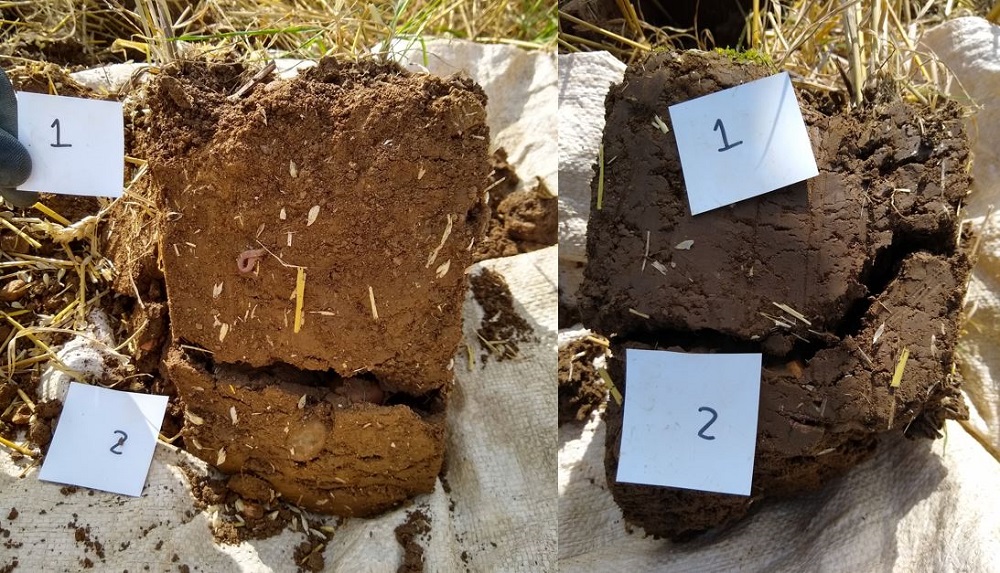Plough vs direct drill: Soil health impact revealed by ‘scorecard’
Wednesday, 15 September 2021
A structured way to monitor changes to soil health is being delivered by a five-year research programme. Dr Jenny Bussell, from the Allerton Project, shows how the ‘scorecard’ has been used to monitor the impact of ploughing a previously direct drilled field.
GREATsoils: AHDB information to help you protect soil and improve its productivity
The minimisation of cultivation can change soil organic matter dynamics, improve soil structure and increase soil microbial and invertebrate populations. It can also save costs (machinery and fuel) and time. However, numerous pressures – such as weeds or compaction – can tempt people to return to cultivating.
With limited information on how much this impacts soil health, a field trial – run by the Allerton Project (2017–20) at their Loddington site – was established to investigate the impact of ploughing a field that was previously direct drilled for seven years. The trial is part of the AHDB and BBRO-funded Soil Biology and Soil Health Partnership.
Three strips were ploughed into the previously direct drilled field, creating three plough plots and three direct drill plots. These were monitored in autumn 2018 (after one year of treatment) and autumn 2020 (after three years of annual ploughing and ten years of continuous direct drill). The soil health scorecard, which uses a traffic-light system to indicate the status of various soil properties (based on thresholds), was used to assess the results (see table, below).
|
Soil property |
Plough |
Direct drill |
||
|
2018 |
2020 |
2018 |
2020 |
|
|
Soil organic matter (%) |
7.1 (M) |
7.1 (M) |
7.2 (M) |
7.9 (M) |
|
pH |
6.8 (M) |
7.4 (M) |
7.2 (M) |
7.4 (M) |
|
Ext phosphorus (mg/l) |
22 (M) [3] |
21 (M) [3] |
26 (M) [3] |
28 (M) [3] |
|
Ext potassium (mg/l) |
162 (M) [2-] |
137 (M) [2-] |
140 (M) [2-] |
173 (M) [2-] |
|
Ext magnesium (mg/l) |
126 (M) [3] |
119 (M) [3] |
104 (M) [3] |
98 (M) [2] |
|
VESS* score |
2.0 (M) |
2.9 (R) |
2.0 (M) |
2.2 (M) |
|
PMN# (mg/kg) |
71 (M) |
54 (M) |
74 (M) |
95 (M) |
|
Earthworms (total/pit) |
6 (R) |
5 (R) |
10 (M) |
5 (R) |
|
CO2 burst (mg/kg carbon) |
143 (M) |
101 (R) |
139 (M) |
116 (R) |
Key:
| Investigate (I) | Review (R) | Monitor (M) |
Numbers in square brackets indicate soil nutrient index.
* Visual evaluation of soil structure
# Potentially mineralisable nitrogen
Earthworms
Earthworms often respond quickly to change. They are also easy to find and count. However, numbers vary seasonally. For example, relatively dry soil conditions may have resulted in low numbers across all plots in 2020. However, lower numbers were recorded in the ploughed plots in 2018 – mostly due to a decline in topsoil dwelling (20 cm) earthworms.
VESS score
The Loddington site is based on clay loam. It is naturally and increasingly compact at depth. It is also vulnerable to cultivation damage. Topsoil structure (25 cm depth) was scored using a visual evaluation of soil structure (VESS), with differences recorded after three years (Figure 1). In the direct drilled plots, the structure in the top layer had a better ‘crumb’ structure. In the ploughed plots, soil aggregates were larger with less continuous pore space.
CO2 burst and PMN
As earthworm numbers are seasonally variable, other measures are being assessed – including simple indicators of microbial activity. The CO2-burst detects respiration in the soil (under controlled conditions). The researchers also used an incubation-measure of potentially mineralisable nitrogen (PMN). Based on these two measures, no clear treatment responses were recorded in this trial.
A system to identify the metabolic fingerprint of the soil microbial community was also tested. MicroRespTM measures the ability of soil microbes to break down soil substrates (based on the release of CO2). It showed that the direct drilled treatment had more than double the metabolic activity of the ploughed treatment in 2020 – suggesting a more active microbial population.
Scorecard strength
The scorecard breaks down soil health into smaller, more manageable, chunks. At first glance, the differences between the direct drilled and ploughed treatments appear small. However, any change detected provides an early warning of a movement in soil health status. As with many things, early intervention can make all the difference. The scorecard approach is due to be finalised later this year.
Ploughing on?
The results support a growing body of research that confirms the benefits of reduced cultivation on soil health. However, the findings also suggest that an occasional more-intensive tillage event will not necessarily result in long-term negative impacts.
GREATsoils: AHDB information to help you protect soil and improve its productivity

Figure 1. VESS profiles and soil layers (1 and 2) from a direct drilled treatment (left) and ploughed treatment (right)

